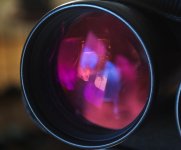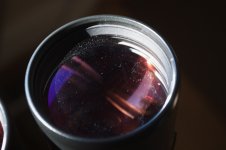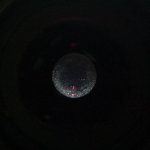Jan and Henry:
My conjecture about what might cause the 3D effect would imply the existence of a tilted focal plane, and as both of you suggested, is likely far-fetched; at least we do not know of any other previous case.
I agree with you, Jan, that the 3D in the NV might be nothing but a "fata morgana" that disappears in a side by side comparison with other binos of the same mag. However some people see 3D in the NV but not so neatly in other binos, and that might have to do with their eyes (I believe that a bit of astigmatism paradoxically might help here), their brain, as well as NV's field curvature pattern.
Peter
It need not be a tilted plane as a manufacturing defect. If you tilt the glass slightly downwards, with a field curved away from you, and focused on an object in the middle of the image, part of the foreground will become sharper than it was with a non tilted glass. One pleasure of curved field.
Pseudo3D due to distortion/curved field (and high micro contrast) is definitely not a Fata Morgana. And beyond binoculars it is quite prominent in lenses for imaging purposes once you look for it. I tested two cine lenses yesterday, high end zooms in a similar range from two manufacturers. One quite flat field with great edge performance - but mediocre dimensionality in the image. The other vice versa, not flat field, bad edge performance, great 3D. I know for sure that most of the audience will not notice bad edge performance in a film, but they will subconsciously notice if people (or animals, or whatever the object in the middle is) look real and 3D in a 2D image, or look like cardboard figures. In the film industry, this pseudo3D quality is definitely cherished by many cinematographers, most of which will prefer Angenieux zoom lenses to the technically sometimes better but flatter rendering Canon zooms. With photographers, some still use their old Canon 17-40/4 instead of the brand new 16-35/4 which is technically almost perfect - but boring flat.
Similar applies to binoculars, with the extra element of real stereopsis. I want my bird in the middle of the image to pop out as 3D as possible, and with fore- and background stretching away as much as possible. This is also why I love the 7x42s, the perspective is the most immersive.
The Noctivid is totally great in this 3D respect, because the Leica engineers did not sacrifice this special quality - which easily happens when young bright engineers take over that don´t have a real emotional connection to the magic of an image. It definitely happened in the Swarovision, and partly in the EDG. In the Zeiss SF funnily not, but that was probably not intentional.






